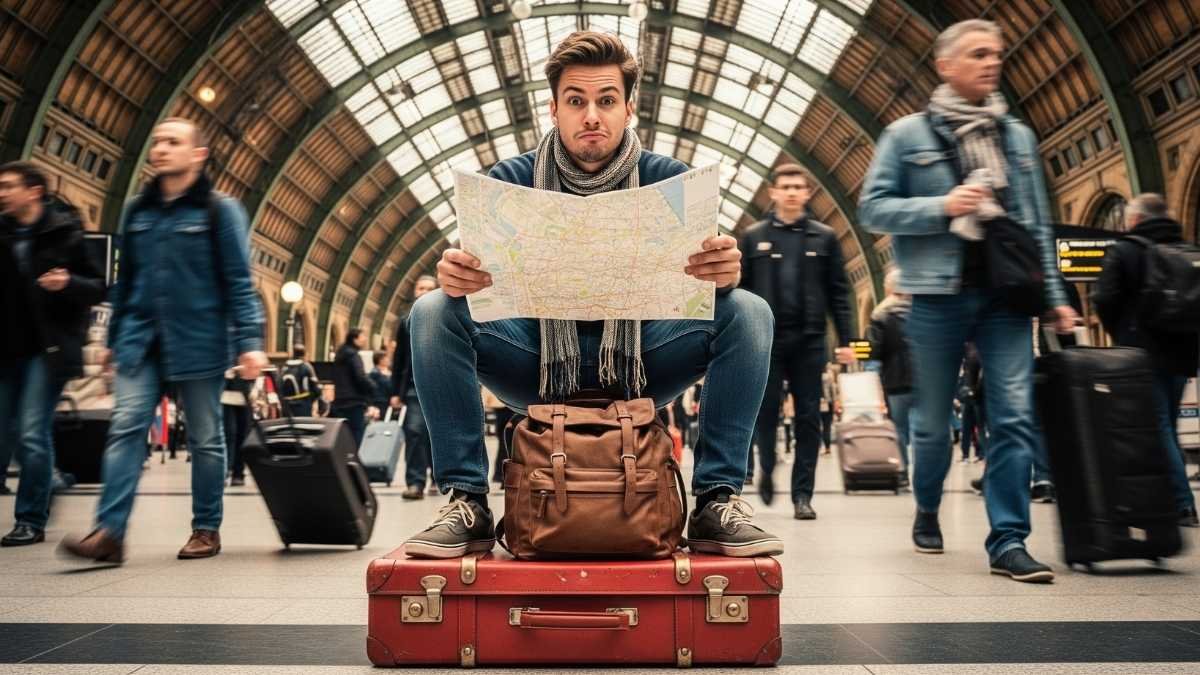
You’re sitting at a charming Greek restaurant, feeling pretty good about your vacation vibes. The waiter brings the bill. €600 for a simple lunch.
Your heart stops. You check the bill again. Surely there’s been a mistake?
Unfortunately, there wasn’t. And here’s the kicker – a local family at the next table just paid €50 for essentially the same meal.
What just happened to you (and how it happens to 1.4 billion tourists every year)
You’ve just experienced the tourist tax in its most brutal form. But here’s what’s really going to blow your mind: it wasn’t your clothes, your accent, or even your guidebook that gave you away.
It was something much more subtle. Something you probably don’t even realize you’re doing.
After analyzing data from over 1.4 billion international tourists and digging deep into behavioral psychology research, I’ve discovered the #1 mistake that immediately brands you as a tourist – and makes you a target for everything from price gouging to petty crime.
Ready for the truth? It’s your behavior when you’re stressed and uncomfortable.
The million-dollar mistake hiding in plain sight

Think about the last time you arrived in a new country. Remember that feeling? Your heart’s beating a little faster. You’re constantly checking your phone for directions. You’re speaking louder because you’re not sure if people understand you.
You’re doing what psychologists call “stress compensation behaviors.”
And locals? They spot these behaviors from a mile away.
Dr. Andrea Brügger’s research on spatial cognition reveals something fascinating: tourists using navigation systems acquire 62.5% less environmental knowledge than locals. Translation? You look lost because your brain is literally processing information differently.
When you’re stressed (which you are, even if you don’t feel it), your body releases cortisol. Your heart rate increases. Your sleep patterns are disrupted. And this biological stress response triggers a whole cascade of obvious behaviors:
- Speaking louder (to make sure you’re understood)
- Over-gesturing (to bridge communication gaps)
- Constantly checking your phone (for navigation and translation)
- Looking around frantically (seeking visual confirmation)
- Asking repetitive questions (for security and reassurance)
Here’s the brutal reality: criminals and scammers are specifically trained to spot these behaviors.
The ASU Center for Problem-Oriented Policing lists “looking like a tourist” as a primary vulnerability factor. They teach law enforcement to watch for people “carrying backpacks, consulting maps, appearing lost” – sound familiar?
The real cost of looking touristy (hint: it’s not just money)

Let’s talk numbers, because they’re pretty shocking:
Financial impact:
- Price discrimination ranges from 15% to 400% markups
- Japanese restaurants charge English-menu customers an extra 200 yen per item
- Italian venues routinely bill obvious tourists €1,100 for meals worth €200
Safety impact:
- 1 in 1,250 tourists become crime victims (vs. much lower rates for locals)
- Tourism fraud is 4 times higher than in other sectors
- Travel fraud increased 28% during 2024’s peak season
Service impact:
- Dual-menu systems automatically charge you more
- Staff provide different service levels based on tourist identification
- You miss out on local specials and insider deals
But here’s what really gets me: this isn’t your fault.
You’re not stupid. You’re not careless. You’re just human, responding normally to an unfamiliar environment.
How different generations accidentally scream “tourist”
Funny thing – the way you give yourself away depends a lot on when you were born.
Gen Z tourists (the Instagram generation)

If you’re Gen Z, you spend an average of $11,766 per trip (impressive!), but you make distinctly modern mistakes.
Your giveaway? Performing travel for social media.
When 88% of your generation follows travel influencers and you’re constantly seeking that perfect shot, locals immediately recognize the behavior. You’re not experiencing the moment – you’re documenting it.
I watched a group of Gen Z travelers in Rome spend 20 minutes trying to get the “perfect” Trevi Fountain shot while completely blocking locals trying to pass by. The eye rolls from Romans were practically audible.
Millennial travelers (the experience collectors)

You guys take nearly 5 trips annually and prioritize experiences over stuff. Props for that!
Your mistake? Assuming your cultural sensitivity works everywhere.
You’ve done your research, you know the major customs, but you miss the subtle stuff. Like not knowing that in some European cultures, you should greet every shopkeeper when you enter, not just browse silently.
Baby Boomers (the comfort seekers)
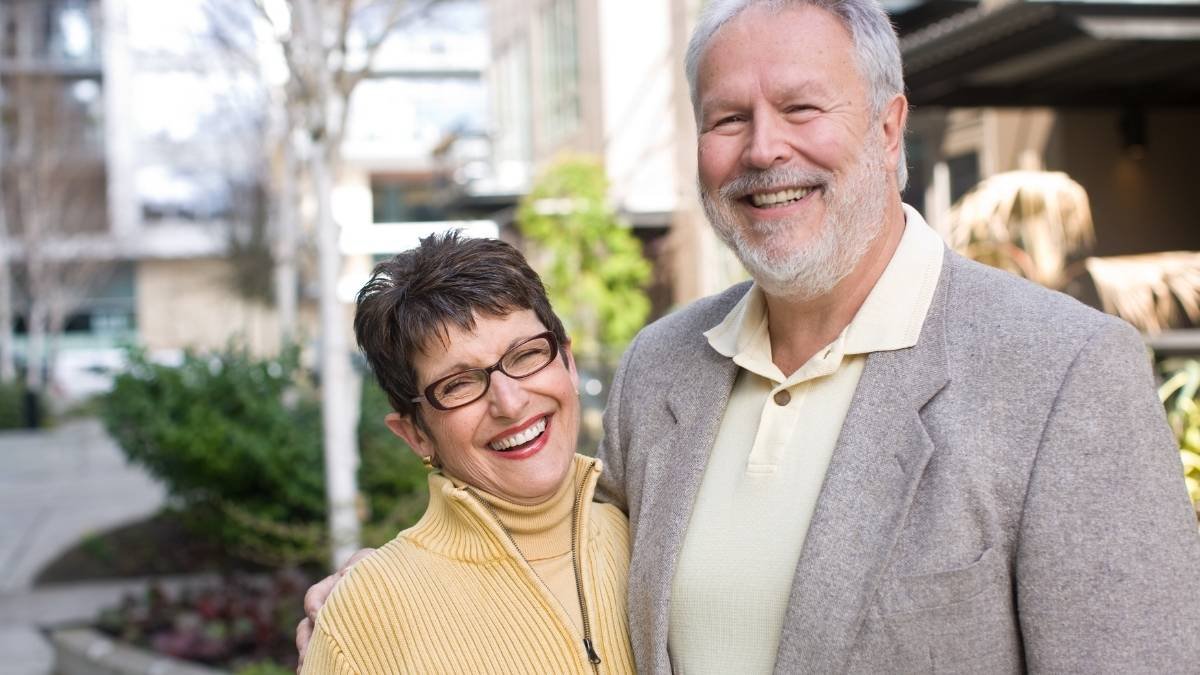
You spend 3 times more per trip than Gen Z, which unfortunately makes you attractive targets.
Your giveaways are classic: overdressing for casual environments, expecting American-style service everywhere, speaking English loudly when not understood, and showing visible discomfort with unfamiliar technology or systems.
Regional reality check: What makes you obvious around the world
Here’s where it gets really interesting – what screams “tourist” varies dramatically by location.
Europe: The subtle art of blending in
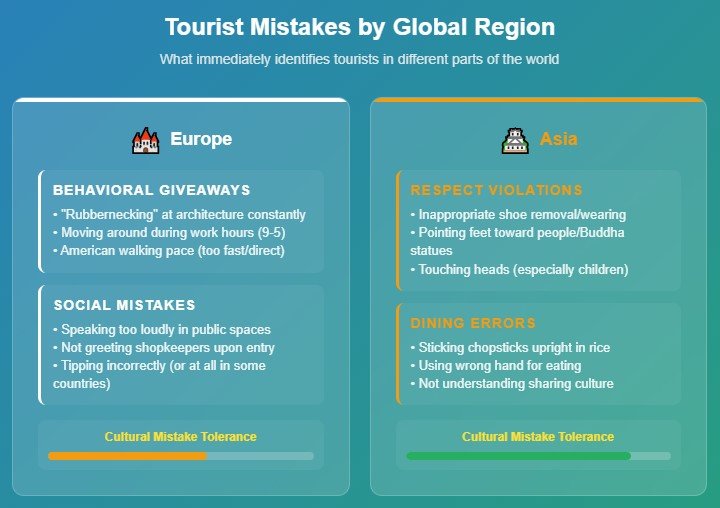
In Europe, Americans get spotted for “rubbernecking” – constantly looking up at architecture, moving around during work hours, and that distinctive American walking pace (yes, you walk differently).
European taxi drivers report being less friendly toward tourists, especially families with children. And those dual-menu systems? They’re everywhere, automatically charging English-menu customers 200-300% more.
Pro tip: Europeans speak quietly in public. If you can hear yourself over ambient noise, you’re too loud.
Asia: The respect rules
In Asian destinations, the biggest giveaways aren’t visual – they’re behavioral.
Major mistakes include:
- Not removing shoes properly
- Using chopsticks incorrectly (never stick them vertically in rice – it resembles funeral incense)
- Speaking loudly in reserved cultures
- Inappropriate touching (especially heads in Buddhist cultures)
The good news? Asian cultures generally show more patience with cultural mistakes, making them more forgivable.
Middle East: The highest stakes
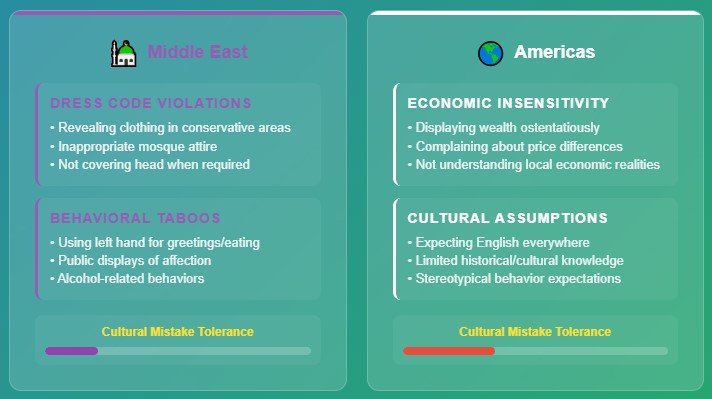
This region enforces the strictest behavioral boundaries. Dress code violations don’t just make you obvious – they can get you in serious legal trouble.
Critical mistakes:
- Using your left hand for eating or greeting
- Public displays of affection
- Inappropriate gestures (thumbs up is offensive in some countries)
- Alcohol-related behaviors in conservative areas
Africa & Latin America: The economic reality
In many of these destinations, economic disparities make tourists obvious regardless of their behavior. But cultural sensitivity gaps make it worse.
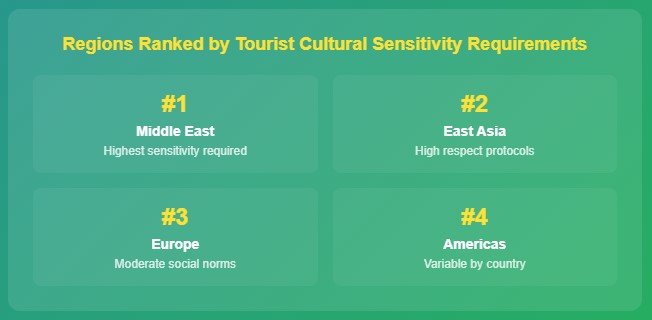
The biggest issue? Arriving with a limited understanding of local histories, customs, and appropriate social interactions.
The psychology behind why this keeps happening

Here’s what’s really fascinating: your obvious tourist behaviors actually serve important psychological functions.
They reduce anxiety. They maintain your social identity. They provide cognitive shortcuts when you’re overwhelmed.
Your brain is literally trying to help you survive in an unfamiliar environment. Unfortunately, these survival mechanisms make you glaringly obvious to locals.
Think about it – when you’re navigating a foreign subway system, your brain is working overtime just to figure out basic logistics. There’s no mental bandwidth left for reading subtle social cues that locals pick up automatically.
This is why “just act like a local” advice is useless. You can’t fake what you don’t understand.
The smart traveler’s playbook: Blending in without pretending
Okay, enough problems. Let’s talk solutions. And no, I’m not going to tell you to buy different clothes or memorize local customs.
Strategy #1: Master the art of calm observation

Before you act in any situation, take a breath and watch locals briefly.
- How loud are they talking?
- How fast are they walking?
- What’s their body language like?
This 10-second pause reduces those overcompensating behaviors that immediately identify stressed tourists.
Strategy #2: Prepare your way to confidence

Pre-download offline maps. Research transportation systems. Identify key landmarks before you arrive.
The goal isn’t perfect knowledge – it’s reducing that visible uncertainty and discomfort that makes you a target.
I always spend 30 minutes before any trip learning the local transit app and mapping my route from the airport. This simple prep eliminates that “lost tourist consulting their phone every 30 seconds” behavior.
Strategy #3: Learn courtesy basics (not cultural perfection)

Focus on essential phrases beyond “hello” and “thank you”:
- “Excuse me.”
- “I’m sorry.”
- “May I?”
- “Where is…?”
Small courtesies create dramatically different interactions. Greeting shopkeepers, removing hats in churches, understanding basic tipping customs – these signal respect, not perfection.
Strategy #4: Manage your stress response

This is the big one. Recognize that feeling overwhelmed is normal and temporary.
When you feel that stress response kicking in:
- Take three deep breaths
- Lower your voice
- Slow your movements
- Make eye contact and smile
These simple adjustments change your entire energy and how locals perceive you.
Real talk: You don’t need to be perfect
Here’s something most travel advice gets wrong: successful travelers aren’t those who perfectly mimic locals.
That’s impossible and unnecessary.
The most successful travelers are those who manage their stress responses, prepare culturally, and project quiet confidence even when uncertain.
You’re going to make mistakes. You’re going to feel lost sometimes. You might even get charged tourist prices occasionally. That’s okay.
The goal is to reduce the obvious behavioral markers that create targeting opportunities while still having authentic travel experiences.
Your next trip starts now
Before you board your next plane, remember this: your travel experience will be determined not by your clothes or language skills, but by how well you manage the psychological challenges of unfamiliar environments.
That €600 restaurant bill? Those systematic price markups? The 1-in-1,250 crime odds? They all stem from tourists broadcasting their uncertainty through predictable behavioral patterns.
But now you know better.
Your assignment for your next trip:
- Research your destination’s basic cultural norms (10 minutes on YouTube will do)
- Download offline maps and transit apps before you arrive
- Practice calm observation in your daily life (it’s a skill you can build)
- Learn 5 courtesy phrases in the local language
- Accept that feeling uncertain is normal – just don’t broadcast it
The travel industry is getting increasingly sophisticated at identifying and capitalizing on obvious tourist behaviors. But armed with this knowledge, you can fly under the radar while still having amazing experiences.
Ready to travel smarter on your next trip? Start with just one of these strategies. I guarantee you’ll notice the difference locals treat you – and your wallet will thank you too.
What’s the most obvious tourist mistake you’ve witnessed (or made yourself)? Share your story in the comments below – let’s help fellow travelers learn from our collective experiences.






